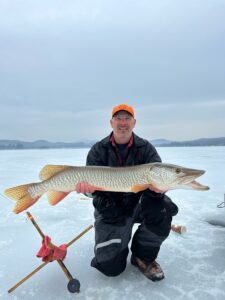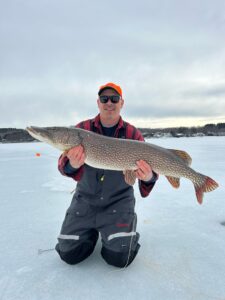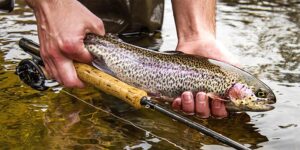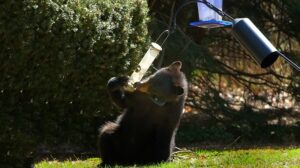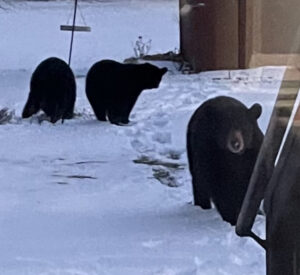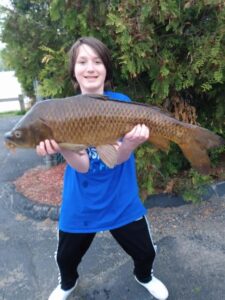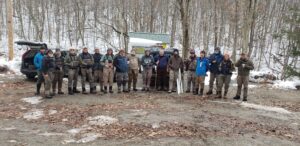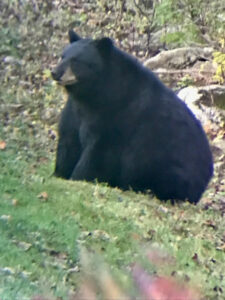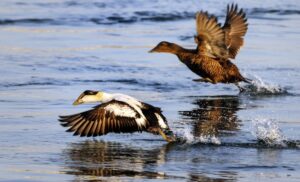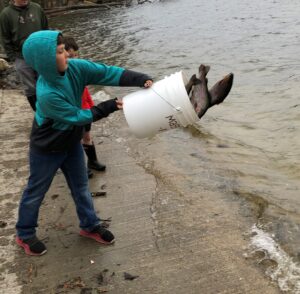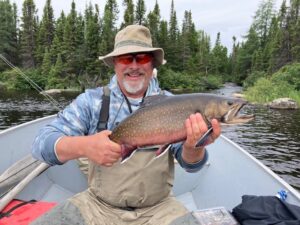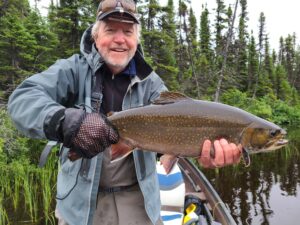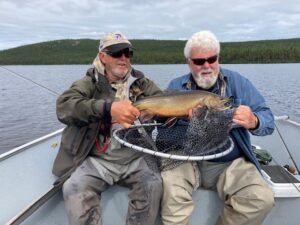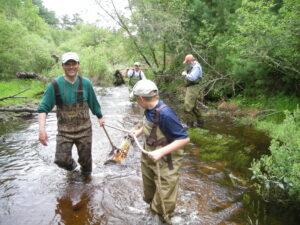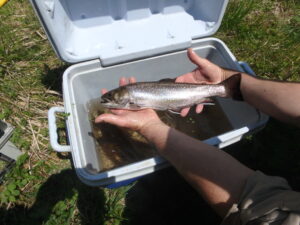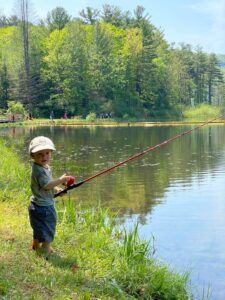What a year of ice fishing Dan Aitken had
On Thursday, March 23, Dan Aitken of Pittsfield was ice fishing alone out on Pontoosuc Lake in the rain. There was about 12 inches of ice with a good 6 inches of solid dark ice where he was fishing. For bait, he was using large golden shiners which he had jigged up earlier.
Just when he was sitting down to eat a snack, the flag on his tip-up went up and he hooked a big fish. It gave him a fierce fight, in fact, Dan said that he had gotten the fish up to the hole 9 or 10 times and each time the fish made another powerful run. Finally, he managed to haul it out. It was a 16 lbs 14 oz tiger muskie (muskellunge) that measured 45 inches. That’s according to the folks at the Onota Boat Livery who weighed it with their certified scales. It was caught out of a 10-inch-wide hole. Dan should get a pin from the state in its Freshwater Sportfishing Awards Program “Catch and Keep” category, perhaps even the gold pin. No tiger muskies were entered into the 2022 sportfishing awards program in any category.
Interestingly, there have been no DFW tiger musky stockings into Pontoosuc Lake since 2016.
Although Dan has released every fish he caught this year, he decided to keep this one so that he could have it mounted. (Kevin’s Taxidermy in Middlebury, Connecticut.)
Unbelievably, Dan had caught an even heavier fish, a Northern Pike, out of Onota Lake just the week before on March 17. That fish weighed 22 lbs 5 oz and measured 43 inches long. His son Shane was with him when he caught that one. Dan released that fish but unfortunately it will not qualify for a pin from the state because he didn’t take the necessary picture required to make it eligible. One look at that fish; however, and you have to come to the conclusion that it would have easily been a “pin” fish, too.
Trout Stocking
The following local waters were scheduled to be stocked last week, subject to change: Deerfield River in Buckland, Charlemont and Florida; Farmington River in Otis, Sandisfield and Tolland; Green River (South) in Egremont, Great Barrington and Alford; Hoosic River (North Branch) in Clarksburg and North Adams, Konkapot River in New Marlborough and Monterey, Westfield River (East Branch) in Chesterfield, Cummington, Savoy and Windsor, Lake Buel in Monterey, Pontoosuc Lake and Windsor Pond in Windsor.
Kids Fishing Derbies beginning at the Hatchery
On the second Saturday of each month beginning in April and running through September the Friends of the Berkshire National Fish Hatchery put on a kid’s fishing derby. They start at 9:00 and run to 10:30 am. What a great opportunity for kids to learn how to fish while competing for prizes. No child goes away empty handed.
The first derby will be next Saturday, April 8 at the Hatchery’s Lower Pool.
Incidentally, the mission of the Friends of the Berkshire National Fish Hatchery is to support and partner with the US Fish & Wildlife Service to help sustain the hatchery and ensure it thrives. It encourages public appreciation for and support of the hatchery, freshwater ecosystems, and recreational fishing in the Berkshires by:
- Engaging and educating the public about the fish hatchery and related conservation, restoration, and ecosystems;
- Supporting the education of school age youth and educators; and
- Encouraging and supporting environmentally responsible recreational fishing.
The year 2022 marked the 150th anniversary of the National Fish Hatchery System. DC Booth, in Partnership with the Friends Group and the Booth Society of Spearfish, South Dakota is constructing a commemorative quilt to highlight the U.S. Fish and Wildlife Service’s current hatcheries, tech centers, and health centers.
Once completed they would like the quilt to travel to displays such as regional offices, major visitor’s centers, and the like. Ultimately it will be stored permanently in the National Fish and Aquatic Conservation Archives in Spearfish.
To complete its contribution, the Friends of the Berkshire National Fish Hatchery turned to no other quilter than their own Marcia Doelman who lives close to the hatchery. Marcia was married to the Friends former President, the late John Doelman and is herself a former Board Member. (I was good friends with John and he greatly influenced me to try fishing for large brook trout up in Nunavik, Canada).
Marcia has been a long-time member of the Peacemakers Quilters in neighboring Monterey. The Friends left the whole project in her very capable hands as to the design and creation of a quilt square to represent the Berkshire National Fish Hatchery. They were very pleased with the resulting square, and it was sent off to South Dakota to be included in the finished quilt.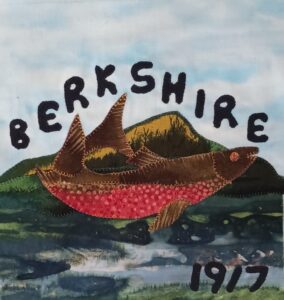
Good for you Marcia! You did a wonderful job.
DFW Land Acquisition
At the March meeting of the Berkshire County League of Sportsmen, DFW Western District Supervisor Andrew Madden reported that MassWildlife had just completed a land protection transaction by acquiring 10 acres along Starkweather Road in Worthington. This parcel is the last lot on Starkweather Road and is surrounded by the Fox Den Wildlife Management Area (WMA). By acquiring this parcel MassWildlife has expanded on the existing WMA and prevented development which would have had a substantial impact on hunting setbacks at Fox Den.
Basic Hunter Education Courses
Basic Hunter Education courses will be offered at:
- Ashfield Rod & Gun Club, 116 North Street, Plainfield/Ashfield on Saturday, April 15 from 8:00 am to 3:00 pm. Attendees (must complete the online study guide before registering).
- Worthington Rod and Gun Club on 458 Dingle Road (Route 112), Worthington on April 17, 18, 20 and 21 from 5:30 to 9:00 pm. Attendance at all dates is required.
To enroll, call (508)389-7830
Taconic Chapter of Trout Unlimited is ramping up activities
After being relatively low keyed during the covid epidemic over the last couple of years, Taconic TU is swinging into action again.
On Thursday, April 13, at 6:00 pm Taconic TU will be hosting at its general meeting DFW Western District Supervisor Andrew Madden and Aquatic Biologist Leanda Fontaine Gagnon as guest speakers. They will be introducing a summary of MassWildlife Western District programs.
It will take place at the Pleasant and Main Café & General Store in Housatonic, MA, which has a general store decor with a strong sporting and fly-fishing theme.
A meal can be purchased for those interested but you will have to BYOB.
Then, on Sunday, April 23 at 2:00 pm, Taconic TU will be presenting the 2023 Fly Fishing Film Tour at the Images Cinema, 50 Spring Street, Williamstown. Tickets which cost $15.00 can be purchased at (https://imagescinema.org/movie/fly-film-fishing-tour-2023).
Following that, there will be a reception hosted by Cheeky Fishing. The reception will be held next door to Images Cinema at ” The Log by Ramuntos” from 4:00 to 6:00 pm. RSVP for the reception (https://cheekyfishing.com/pages/tu-cheeky-rsvp).
They will have raffles for items throughout the film and at the reception. These will be serious raffle and auction items such as Orvis items, Cheeky Fishing, Yeti, Wingo Outdoors, restaurants, guided fishing trips and at least two rods. Someone will leave with a Francis “Digger” Degere bamboo fly rod worth over $1,200. The late Degere was an internationally known bamboo flyrod maker from Adams. He passed away in November, 1999 but his rods continue to be in high demand.
The screening of the film is sponsored by: Cheeky Fishing, Wingo Outdoors, Mezze Restaurant Group, Wild Soul River, and Moresi & Associates Development Company
Out of Commission
Due to circumstances beyond my control, I won’t be able to completely assemble next weekend’s column. I have asked local flyfisherman Marc Hoechstetter from Cummington to step in and relate one of his flyfishing experiences on the Deerfield River. I’m sure you will enjoy it.
Also, I won’t be able to provide the latest trout stocking report, but you should be able to find out where trout stockings have taken place by clicking onto the MassWildlife web page https://www.mass.gov/service-details/trout-stocking-report.
Hopefully, I’ll be back at the desk the following week.

